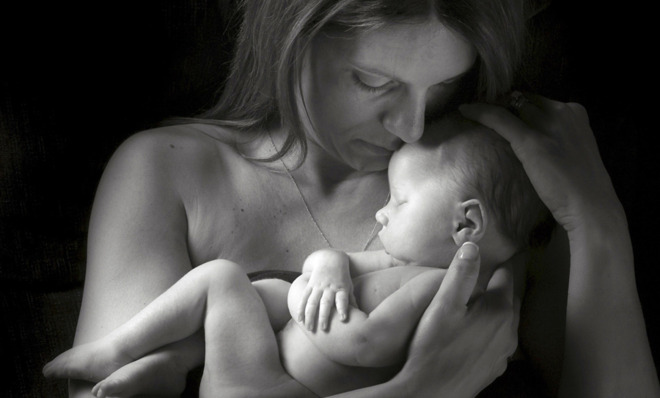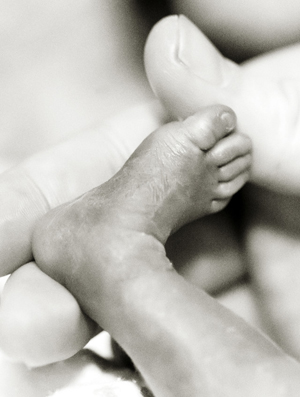Capturing the briefest of lives
When an infant dies or is delivered stillborn, distraught parents face the heart-wrenching process of how to memorialize a child who doesn't survive


Terrah Tillman and her husband had been trying to have a child for five years. After several miscarriages, they had all but given up on the prospect when Tillman unexpectedly became pregnant with a girl, Berlyn, due in early May of 2013.
"It was everything I dreamed of," says Tillman, a 34-year-old child therapist from California. "I went to prenatal yoga classes. We got so involved; we wanted to do a natural childbirth, so I had a doula and we had a childbirth educator and tons of support."
A few days after Berlyn's original due date, Tillman went into labor and called her doula to her home, where she was ready with candlelight and music.
The Week
Escape your echo chamber. Get the facts behind the news, plus analysis from multiple perspectives.

Sign up for The Week's Free Newsletters
From our morning news briefing to a weekly Good News Newsletter, get the best of The Week delivered directly to your inbox.
From our morning news briefing to a weekly Good News Newsletter, get the best of The Week delivered directly to your inbox.
"It was all very pretty," she says, gently recalling the scene. "Our family was coming in from out of town to see her. This little baby girl had been waited for, for five years, and we were so excited."
But at the very last minute something went horribly wrong. Tillman felt no movement from the baby and ended up rushing to the hospital. Once there, doctors could no longer locate Berlyn's heartbeat.
When Tillman and her husband were told Berlyn would be delivered stillborn, they were beyond devastated.
"A specialist came in and I just grabbed her," recalls Tillman. "I yelled, 'Please do something, please save her.'"
A free daily email with the biggest news stories of the day – and the best features from TheWeek.com
(More from Narratively: The New York Do-Gooders network)
Before Tillman could get over her complete shock, she was suddenly confronted with new and painful decisions that she couldn't yet bear to think about. When a nurse first mentioned Now I Lay Me Down To Sleep, she recalls that she hated the sound of the organization's name.
This is how families usually first learn of Now I Lay Me Down to Sleep (NILMDTS), a national nonprofit organization that provides free remembrance photography of dying or already deceased babies.
NILMDTS was co-founded by Colorado-based Cheryl Haggard and Sandy Puc in 2005, after Haggard lost her own newborn. The group brings in volunteer photographers within hours of the infant's passing, and the photographers complete post-production work at their own expense. While hospitals often provide their own services or bring in independent volunteers, many families and medical specialists report that the high-quality services provided by NILMDTS and a few similar organizations are invaluable.
As Sharon Nord, a perinatal nurse and the New York City area coordinator for the organization, explains, the moments surrounding an infant's passing are typically hazy and disorienting for family members, and of course they will never have the lifetime of pictures people can rely on when an older person passes away.
"The families we assist will never have those pictures," says Nord. Above all, NILMDTS provides a poignant memory of a child that might otherwise not be celebrated.
Tillman's sister-in-law had the presence of mind to call NILMDTS and have a photographer meet them at the hospital. But by the time the photographer arrived, Tillman was hysterical and uncomfortable with the idea of having Berlyn photographed.
Tillman turned to a nurse and told her she had no idea what to expect, asking her what Berlyn would look like when she was delivered.
"The nurse said Berlyn would look beautiful," recalls Tillman, "and just like she was asleep."
Tillman eventually agreed to a portraiture session, but it was painful for her to witness.
When a baby passes, its skin quickly goes through changes that can be quite jarring to see. Oftentimes these sessions involve moving and positioning the baby, an act that takes great care and attentiveness. Some parents want to watch their babies photographed and some prefer not to. Similarly, some parents want to be in the photos while others turn that option down.
As the photographer did her work, Tillman chose to look away.
(More from Narratively: Drinking with the dead)

Several years ago, when Stacy Rader found out her son Caelan was not going to survive after taking a turn for the worse in the NICU, she immediately dismissed the idea of having him photographed.
Stacy Rader's son Caelan Rivera O'Connor, who passed away in 2008, photographed by Melanie Moreno.
"The doctor told me about Now I Lay Me Down to Sleep and I had no interest," says Rader. "I thought, 'You don't take photos of these horrible moments in life.'"
But something changed when Rader's nurse, Eugene, approached her in tears and urged her to have the pictures taken.
Rader, now 39 and Director of Communications at the Colorado League of Charter Schools, says Eugene, who himself had been present at the founding of NILMDTS, told her she would want those photos, that they would represent her legacy.
Rader was so out of it she recalls little of the experience and could barely remember the photographer or even the name of the group. But in time, she grew to be tremendously thankful for the memories.
"Even now I cherish [the photos] and I can remember details that have started to fade with time," says Rader. "I can smell and even feel Caelan again. I'm so thankful I had the photos done; they're all I have."
(More from Narratively: Up close and personal with the gun lovers of NYC)
Todd Hochberg, 57, a Chicago-based photographer with a background in medical photography, has been a near full-time bereavement photographer for the past eight years. He also teaches and lectures on the subject.
Hochberg is not affiliated with NILMDTS and considers himself a documentarian. He loves collecting vintage photographs, and compares his work to memorial photos made in Victorian times to capture the dead or dying. He believes each of those images and daguerreotypes, often of children and babies, tells an important story.
"I thought I would do what I had seen in the Victorian photographs — portraits or photos with family," says Hochberg. "But what I discovered was this incredible story of love and loss and that's why I brought the documentary approach to these images."
Hochberg has received grants and donations to support the work he does, which is free of charge for families. In 1997, he founded his own organization, Touching Souls, as he knew of no other service like it at the time.
NILMDTS photographers typically spend between 30 minutes to an hour in their sessions. In cramped, busy hospital rooms, they balance professionalism and intimacy while assisting grieving families. Hochberg says he will spend anywhere from 45 minutes to five hours or more on a shoot. Sometimes he will even spend several days with a family, documenting the entire experience.
"I'm doing a documentary story," says Hochberg. "I try to provide a full narrative, considering families' needs and wishes."
"There's always a quintessential moment or image for me," he adds. "It is often the same one for the family — the image that speaks most powerfully."
Right photo: Stacy Rader's son Caelan Rivera O’Connor, who passed away in 2008, photographed by Melanie Moreno. (Narratively/Menalie Moreno)
Read the rest of the story at Narratively.
Narratively is an online magazine devoted to original, in-depth and untold stories. Each week, Narratively explores a different theme and publishes just one story a day. It was one of TIME's 50 Best Websites of 2013.
-
 A lemon-shaped exoplanet is squeezing what we know about planet formation
A lemon-shaped exoplanet is squeezing what we know about planet formationUnder the radar It may be made from a former star
-
 Political cartoons for January 4
Political cartoons for January 4Cartoons Sunday's political cartoons include a resolution to learn a new language, and new names in Hades and on battleships
-
 The ultimate films of 2025 by genre
The ultimate films of 2025 by genreThe Week Recommends From comedies to thrillers, documentaries to animations, 2025 featured some unforgettable film moments